Breguet
The History and Romance of the French Military Issue Type 20
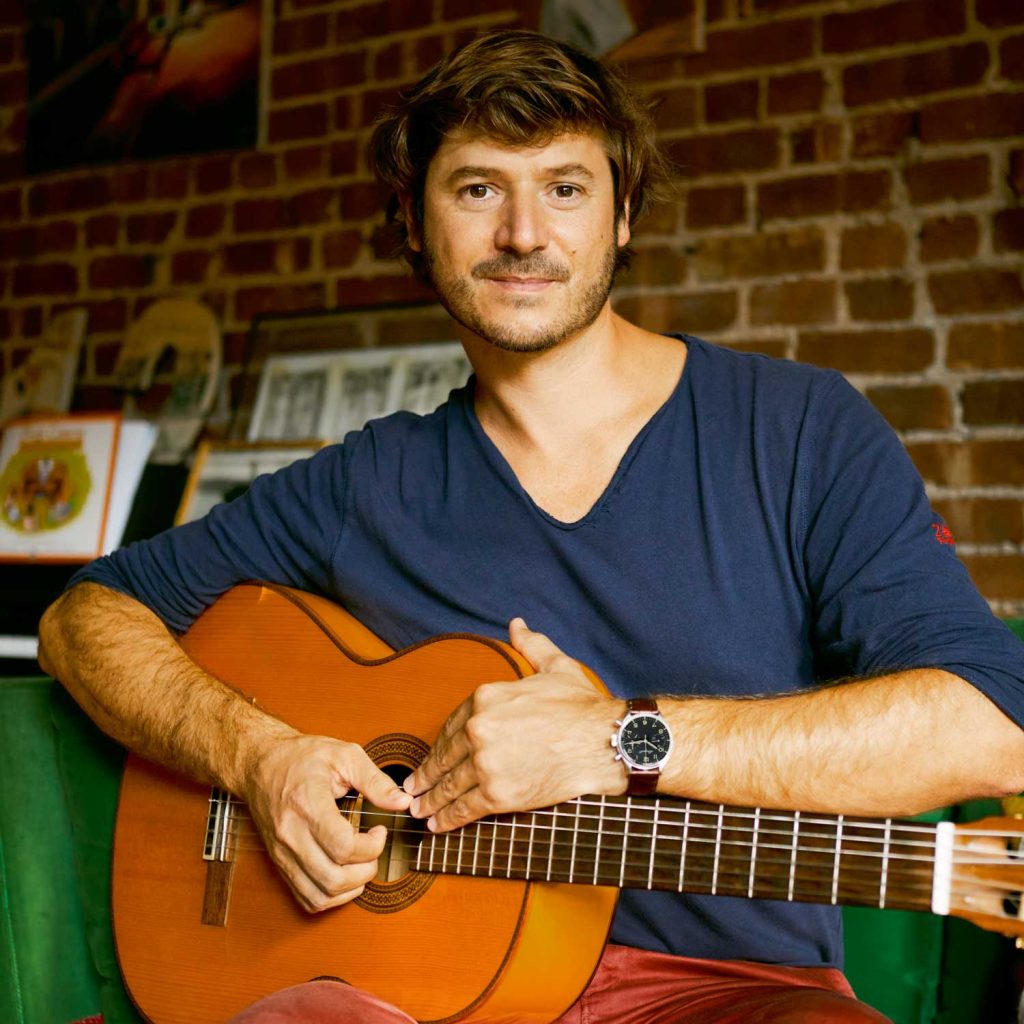
Christophe (a.k.a. @Toiche)
Christophe was more than happy to oblige, explaining the watch’s authentic roots. Like many military pieces, he told me, the Type 20 was born of a nationwide government request, asking watchmakers to propose a hard-wearing, flight-ready design.
“The requirements were typical for a 38mm stainless-steel military pilot watch: a chronograph, a black dial — a clean dial, so it is easy to read for a pilot — [with] luminescent Arabic numerals and hands,” he explains. “The request was also for the flyback. The flyback function is where you can reset the chronograph just with one push, so there is no need to stop and reset. With only one push, it resets and starts again,” Christophe says. Indeed, each second lost during chronograph reset could misguide the pilot during the flight, hence the importance of such a function.
“There are many Type 20 watchmakers, even Girard-Perregaux. There is even an AVI version from Breitling that looks very similar. I don’t know if Breitling answered this contest directly at that time, but for sure Vixa, Dodane, Auriscote, Airain, and Breguet answered. And the one that was selected by the government was the one from Breguet.”
The Original Type 20s
If it’s not already clear, Christophe is something of an expert on the Type 20. He’s researched the history of this special watch extensively, conducting interviews to piece together its history. His passion for these exceptionally rare timepieces is rooted in a childhood love of mechanical clocks and a lifelong obsession with Breguet’s adventurous past. He divides the Type 20 story in “batches” of production. The first run of around 2,000 pieces arrived after Breguet won the government contract, these watches are all stamped with a “Breguet Type 20 5101/54” engravement on the back used as a reference to the government contract number.
“As Breguet needed to produce a large number of watches in a short amount of time, the production of the watches was contracted and assembled by Mathey-Tissot using the Valjoux 222 movement,” Christophe says. “Then there was a new batch after that in the ’60s for the Marine Nationale, the famous Aéronavale. There were 500 of those “Aeronavales” produced. This Marine Nationale version is easy to identify with the “Big eye” sub-register calibrated on 15mn (instead of 30 minutes for the first batch), corresponding apparently to the required time to complete the pre-flight aircraft checklist on the carrier. They [also produced] the three-register CEV [model] for the Centre d’Essais en Vol (French Flight Test Centre), and made about 50 of them.”
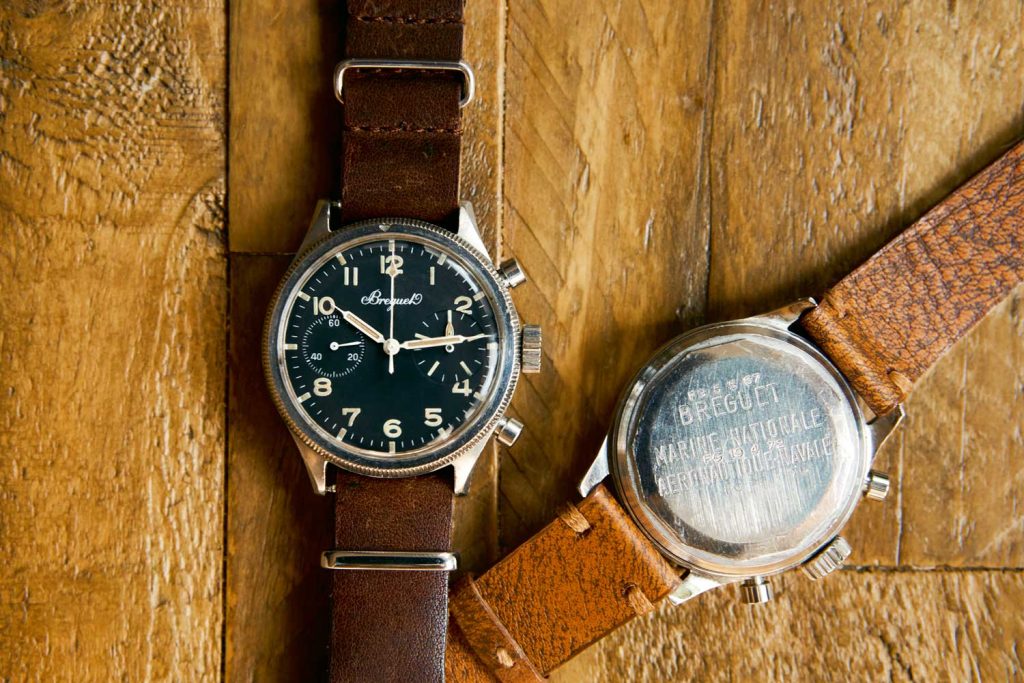
A “Big-Eye” Breguet Type 20. A fine example of the Marine Nationale military engravings on the case back provides clues to the past.
Still, the scarcity of the original military issue pieces drives Christophe’s obsession. During his initial research, Christophe decided to cut through the noise and simply contact pilots directly. What he learned was astounding: “Those military watches, once they [went] to the Army, needed to stay within the Army. We know precisely how many got produced. Many people told me — the pilots, former pilots — when people were leaving the Army, they had to give all the gear back. All the uniforms, belts, helmets, packs, everything. Even the watches … they had to go back to the watchmaker, and he was smashing the watch with a hammer and tossing them in a bucket.
“So the idea was to destroy them because the military didn’t want those watches getting out. The only way to withdraw those watches was for pilots who were part of a critical situation during a flight, like a near-death experience, like when they were ejected or an accident. I don’t know, maybe something very exceptional occurred in their career, they might be able to keep their watch. But those cases are really, really, rare. And then the last possibility was for pilots to pretend they lost the watch and to keep it, basically to steal it.
“I tried to find former Marine Nationale pilots or French Air Force pilots hoping to acquire a watch, and they all told me the same thing. Of all the people I contacted, none of them were able to keep the watch. They all had to give it back. As a collector, my first goal was to find watches. And when I contacted pilots, they all told me the answer: ‘No.’”
“The funny thing is, the pilots told me that the chronograph watch was more for backup. The information [the watches] provided was already on board in the aircraft. All the tools, all the gear needed were part of the instrument panel. The watch was more to be used in case of deficiencies with onboard instruments or if they got ejected or had any other issue,” Christophe says. “So that’s how I would like to imagine those pilots using those flyback function chronographs. But in reality, it was more like a daily watch, a mandatory watch to wear.”
The Beginning of a Super Niche Collection
This is where a collector’s dreams take over. Because, for those of us like Christophe, the allure of the Type 20 rises far beyond its time in the sky.
“It’s my dream that these watches got used for their intended purpose. Still, I know those watches retain a lot of history. That’s true because those pilots [flew many] hours on aircraft carriers or with the regular French Air Force. There are so many hours of intense flights, for sure.”
While modern equivalents can be found in many collections, this utilitarian-military watch has become increasingly rare. Finding one these days can seem like rediscovering a long-extinct species. Yet Christophe has amassed more than a dozen. Seeing them together was a rare, incredible sight.
The collecting bug began quite young for Christophe. “When I was 12, I had an entire Napoleon-style clock in my bedroom. So it’s more like a grandfather clock. But I was spending my time trying to fix it, trying to examine the movement. With every half an hour and every hour, a bell, ‘ding, ding.’ I loved that. I spent a lot of time looking at watches, and I had a strong interest in Swatch. Then I discovered the mechanical version of Swatch. That was a fascination for me. I was like, ‘Wow. What is it?’
“Later, around 2008, I came to New York, and I remember stopping by the Wempe store on Fifth Avenue. I began spending more and more time looking at watches. But still, I was not buying them,” Christophe says. “And one day, I went to a French-type Craigslist, and I saw an authentic Breguet pocket watch for sale. An 18K gold pocket watch. And just this name Breguet, I knew the name because it’s classically French and very famous as a watchmaker.
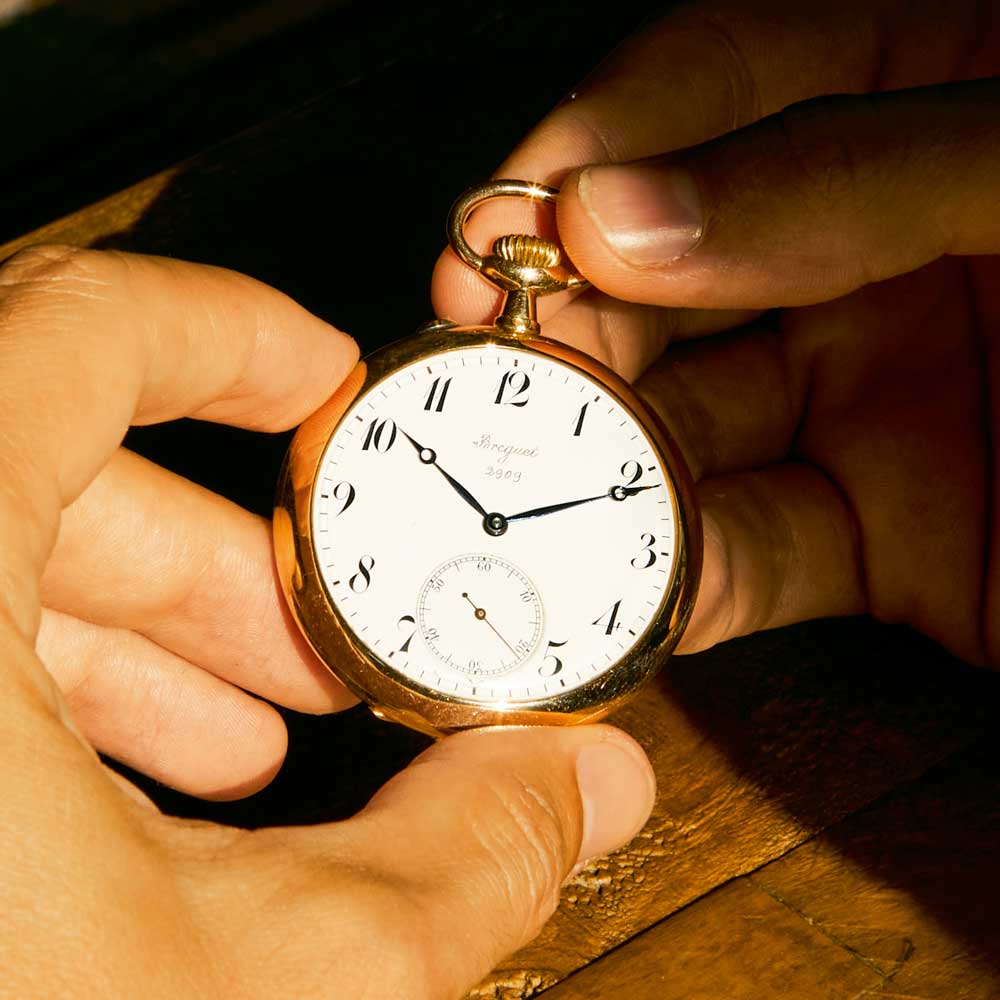
The gold Breguet pocket watch that initially inspired the collection.
The Breguet lore took hold. “It was from the early 20th century, so it was maybe 1915 or ‘16. Decent. I saw something on this watch, on the dial. There is a famous thing with Breguet on pocket watches, the secret signature. A Breguet invention in the 18th century, a tiny signature to prevent fake watches and counterfeiting. And the one I bought had a similar little secret signature engraved on the enamel dial below the “12”, so that was that for me.”
The extraordinary records kept at Breguet provided more history. “This was when I contacted Emmanuel Breguet to help with certification. And Mr. Breguet was so polite and friendly, and just asked me for pictures and the serial numbers. And he provided me with the full watch history. When it was manufactured, the price when sold, and who the buyer was at the time.”
“I was so impressed with the Breguet archives. Then I met with Emmanuel Breguet a couple of times, which is when I started buying more pocket watches. That’s why I’m telling you my first passion was always about Breguet. I bought one for my son’s birth and another one for my wedding, I bought more and more. And each time I contacted Emmanuel Breguet, he gave me information.” This is where Christophe’s collection began in earnest.
“One day, I bought an extraordinary pocket watch, a Marine Nationale deck chronometer. The equivalent of the Type 20, but for the deck.” This further fueled Christophe’s desire to collect. Auction houses were the first stop. Private collectors came next. “I’ve got a total of 12 Type 20s. I’ve got four Marine Nationale. Just to find those four Marine Nationale, it took me a lot of time.”
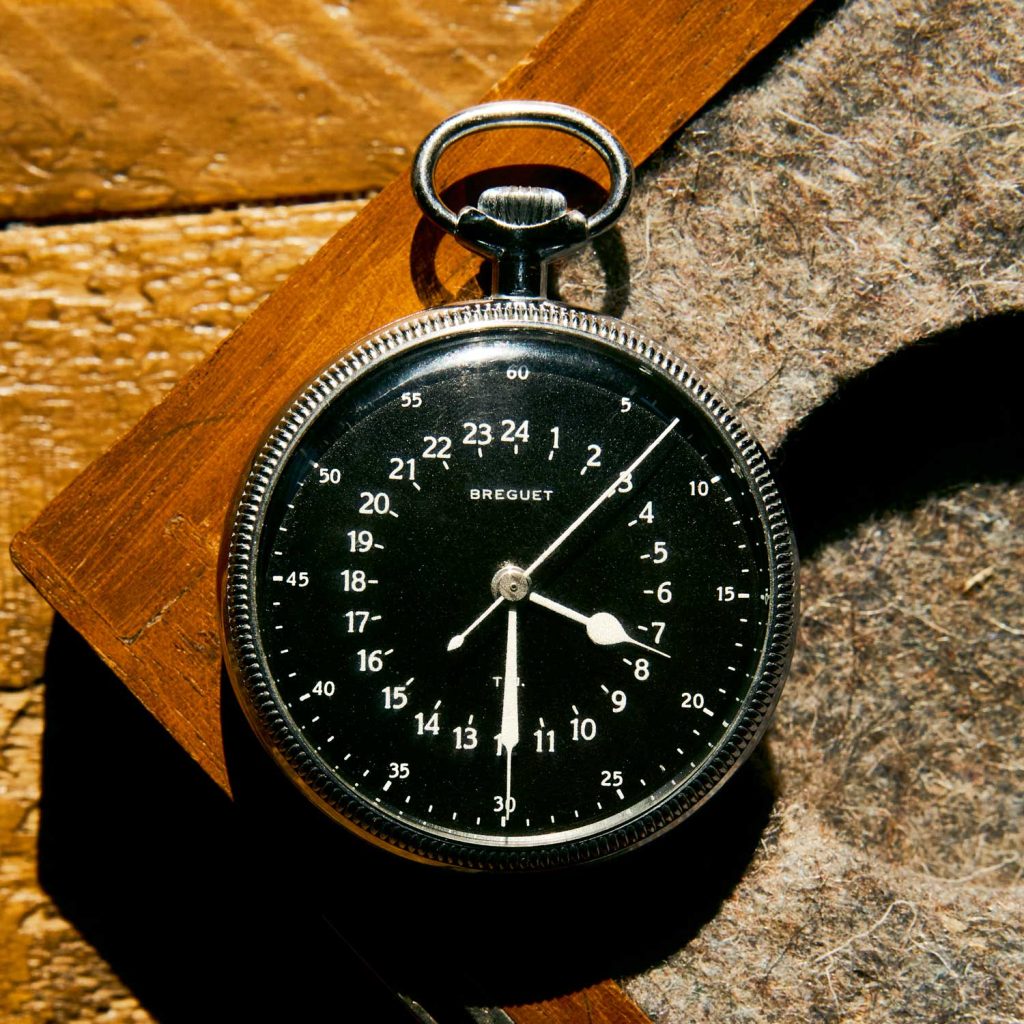
A rare Breguet dashboard pocket watch used to calculate longitude.
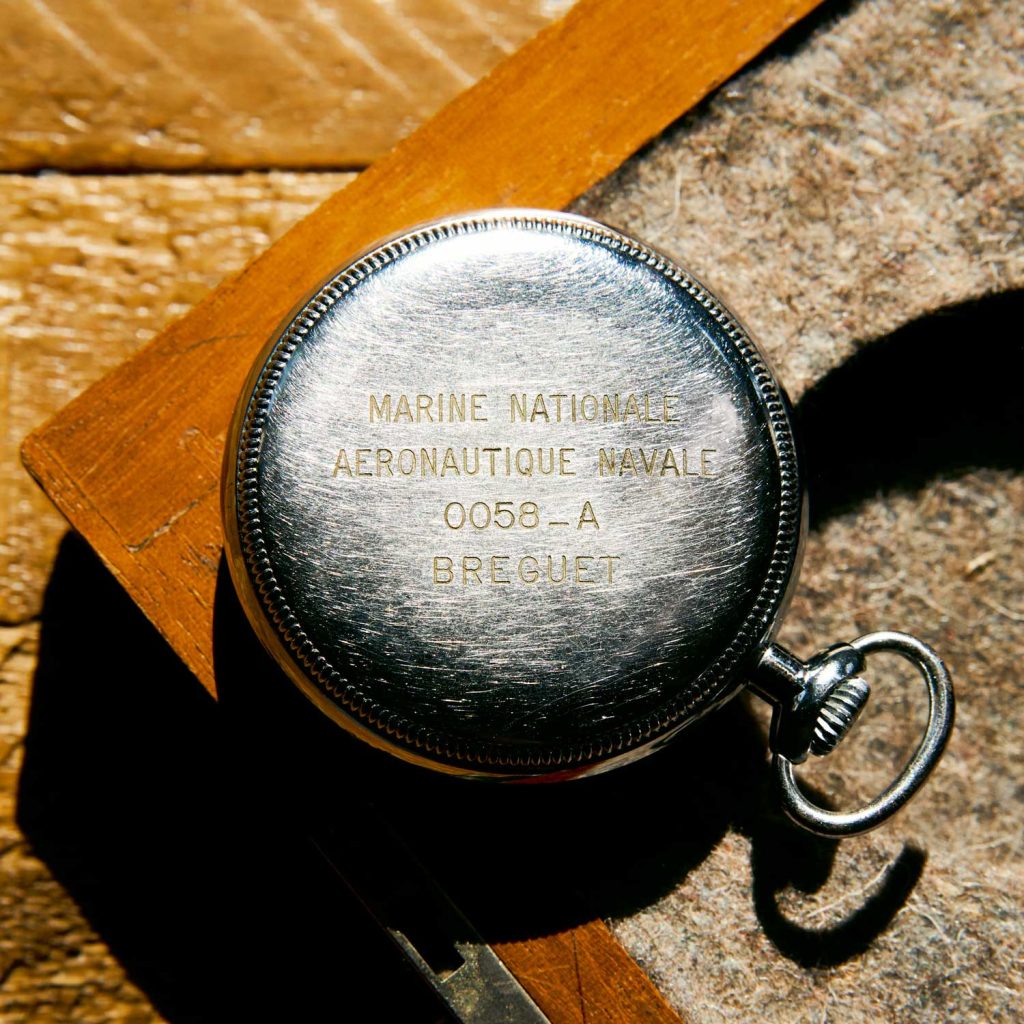
A rare Breguet dashboard pocket watch used to calculate longitude.
Beyond the Breguets
Is there a desire for more? What’s left? “I would like to open my collection to Tudor, the Tudor Marine Nationale. Tudor, these are also quite famous and full of history, the steel tool watches. My dream is also a Rolex Milsub. These are quite expensive now, so I guess it will be tough.” While prices might keep the collection in check, there are still some unexpected watches that catch Christophe’s eye.
He shows me a watch that he purchased for about $50, and the gleam in his eye is similar to his gaze for his rare Breguets. “What I also like are Russian watches. It’s a Raketa, with a 24-hour dial. This brand used to be very well known and popular in Russia. It has a great movement, really robust. It’s not a luxury watch, but it works well. They provided those watches to KGB, and I like this style, a 24-hours blue dial.”
Christophe says new collectors should simply buy what they like. “I may not be the world’s biggest expert on Breguet Type 20, but I love them. I admire Breguet, the French military history, the look of these utilitarian tool watches. And sometimes just liking something for the sake of liking them is enough.”
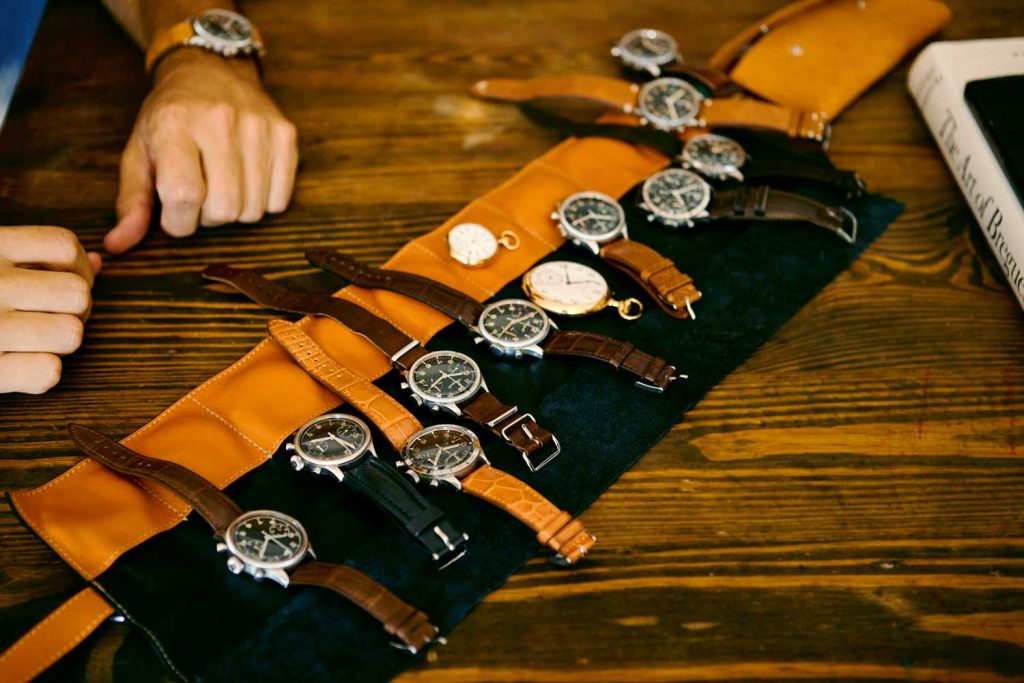
A fourth-generation descendant of Abraham-Louis Breguet would later found Breguet Aviation, a tie that would lead Breguet to supply the French military with the Type 20 military watches. A small selection from @Toiche collection of Breguet Type 20 watches, all worn regularly, a rare sight to behold.










